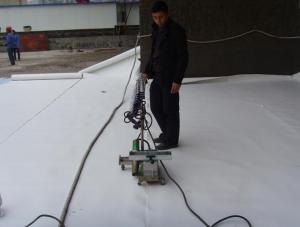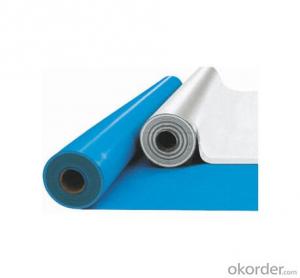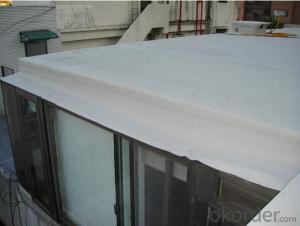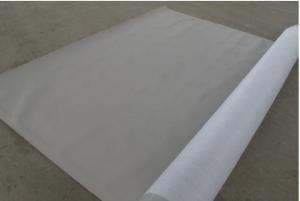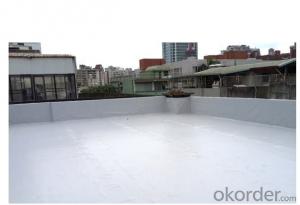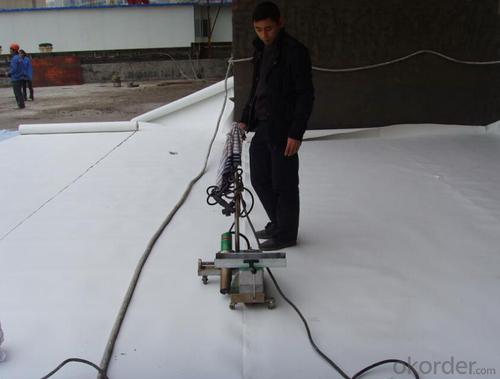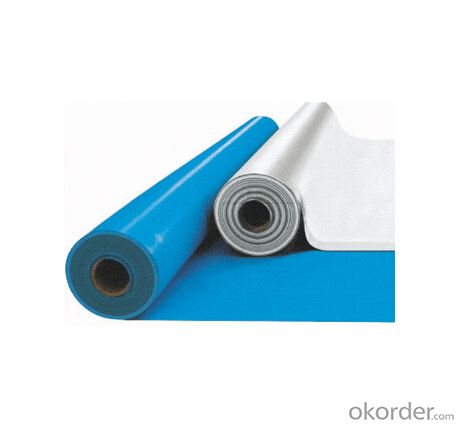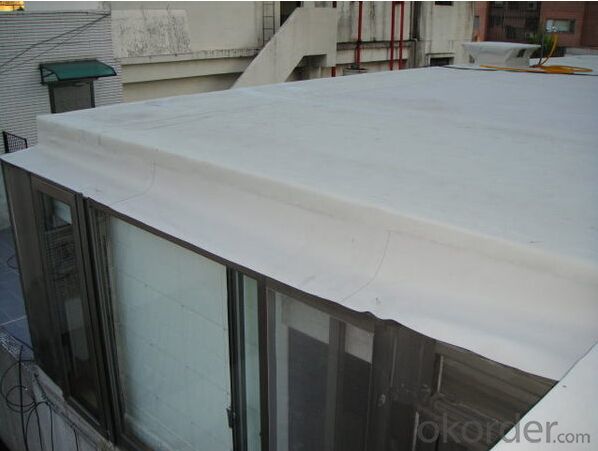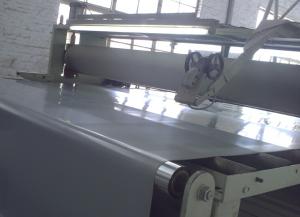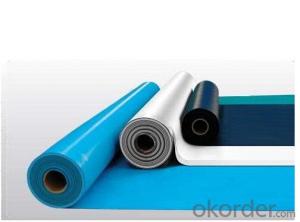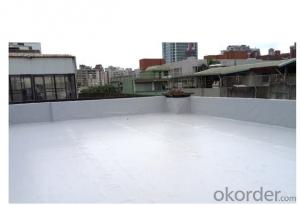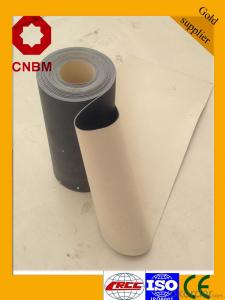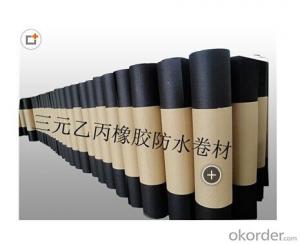PVC Roofing Waterproof Plastic Membrane
- Loading Port:
- Qingdao
- Payment Terms:
- TT OR LC
- Min Order Qty:
- 2000 m²
- Supply Capability:
- 300000 m²/month
OKorder Service Pledge
OKorder Financial Service
You Might Also Like
Introduction of PVC Waterproof Membrane
It is an excellent high quality polymer waterproof sheet, made of PVC resin by adding plasticizer, anti-UV agent, anti-aging agent, and stabilizer and other processing aids through extrusion and molding.
As the highly recommended product by the Ministry of Consturction, it is featured by high tensile strength, great elongation, good stability, small shrinkage, low temperature performances, good resistance to weathering and root penetration and long service life.
.
Features of PVC Waterproof Membrane
1)Excellent aging resistance. Service life of roofing material is over 20 years; service life of underground material is over 50 years.
2)Root resistant penetration, specially used on planting roofings.
3)Welding installation. Joints are solid and environment friendly, no pollution.
4)High tensile strength, good elongation and dimensional stability.
5)Good plasticity, easy and suitable for details installation.
6)Fireproof. Fire extinguished out of the ignition resource.
7)Surface is smooth, no fading and dirty resistant.
8)Width is over 2m. Construction wastage is small, more economical.
Classification and Specification of PVC Waterproof Membrane
N: Homogeneous PVC membrane
L: PVC membrane with fabric backing
W: Reinforced PVC membrane
Thickness: 1.2mm/1.5mm/2.0mm
Size: 2.05mx20m
Color: white/grey, or any other colors.
Advantage of PVC Waterproof Membrane
1.) Mixing automation. Apply automatic temperature control automatic time control and automatic feed control.
2.) Extrusion equipment uses twin screw coextrusion. Screw temperature uses computer automatic temperature control system.
3.) Handpiece uses large width didhead extrusion equipment.
4.) Sophisticated three-roller calender equipment. The space between equiment is controlled by automation system.
Application of PVC Waterproof Membrane
PVC membrane applies special formula and its service life is much longer than other general waterproof membranes. Its excellent performance makes it be widely used in every field.
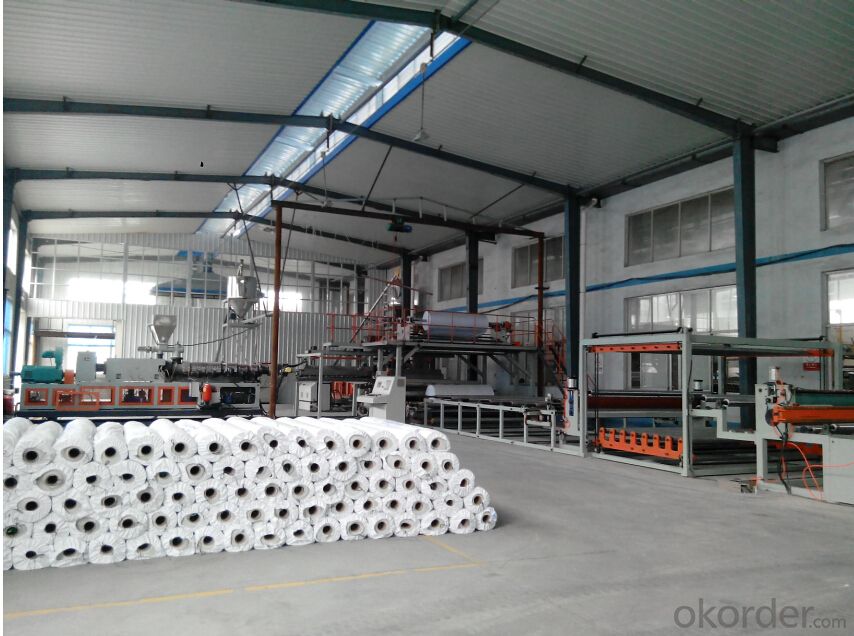
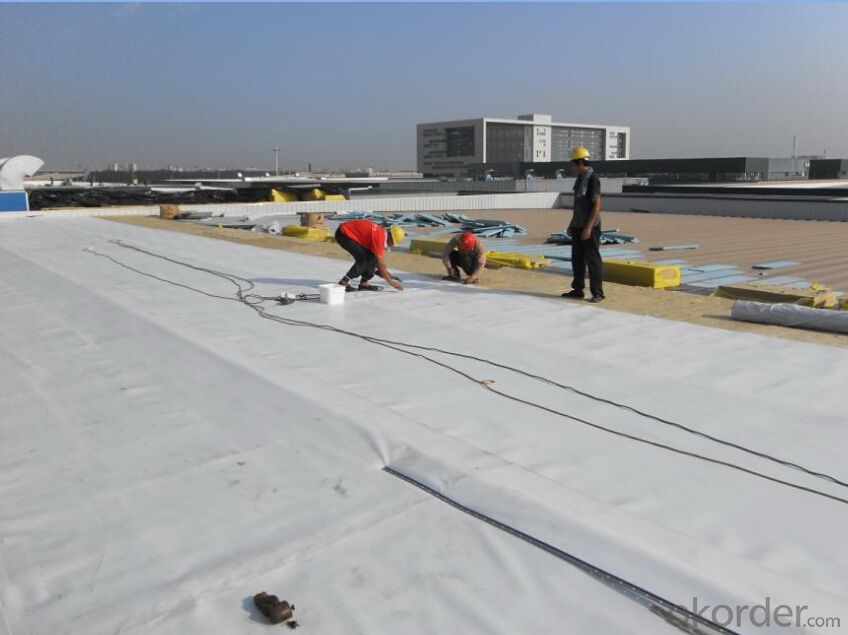
FAQ:
Can you produce 4m width?
Yes, no problem for us. We have four bases in China, largest one in this field.
How many quantity in one 20'' container for 1.2mm and 1.5mm?
480rolls, 11520m2 for 1.2mm and 400rolls, 9600m2 for 1.5mm
Can you provide free samples?
Yes, our samples are free, but express fees usually on buyer's account.
- Q: Can a waterproofing membrane be used in elevator pits?
- The utilization of a waterproofing membrane in elevator pits is possible. Due to their subterranean location, elevator pits are susceptible to water intrusion from sources like groundwater or moisture. A waterproofing membrane acts as a safeguarding layer that is applied to the walls and floor of the elevator pit, effectively obstructing the passage of water. This protective barrier prevents water from causing harm to vital components of the elevator system, such as electrical equipment, pumps, and hydraulic systems. Implementing a waterproofing membrane in elevator pits substantially diminishes the likelihood of water damage and corrosion, ensuring the elevator's safe and efficient operation.
- Q: Can waterproofing membranes be applied over existing surfaces?
- Applying waterproofing membranes over existing surfaces is indeed a common practice in construction and renovation projects. These membranes serve as a protective barrier against water infiltration and can be used on various surfaces like concrete, wood, metal, or even other waterproofing systems. By applying a waterproofing membrane over an existing surface, it effectively prevents water damage such as leaks, mold growth, and structural deterioration. However, it is crucial to properly prepare and clean the existing surface before applying the membrane to ensure optimal adhesion and performance. It is also advisable to seek guidance from a professional waterproofing contractor to determine the most suitable membrane type and installation method for your specific project requirements.
- Q: Does a waterproofing membrane prevent water infiltration through concrete?
- Yes, a waterproofing membrane is designed to prevent water infiltration through concrete. It acts as a barrier, preventing water from seeping through the concrete and causing damage.
- Q: Can a waterproofing membrane be used on storage tanks?
- Indeed, storage tanks can benefit from the application of a waterproofing membrane. These specialized membranes serve as a barrier, preventing the infiltration of water or other liquids into the surface they are applied to. By employing such membranes, storage tanks are shielded from the detrimental effects of leaks, corrosion, and moisture-related damage. Numerous industries, including oil and gas, chemical, and water treatment, rely on waterproofing membranes to uphold the durability and longevity of their storage tanks. Furthermore, these membranes can be customized to meet specific requirements, such as resistance to chemicals, UV exposure, or high temperatures, thus making them well-suited for a diverse array of storage tank applications.
- Q: Can a waterproofing membrane be used for roofing?
- A waterproofing membrane is a suitable option for roofing and is commonly chosen for many roofing applications. Its purpose is to create a barrier that prevents water from infiltrating, thus preventing leaks and water damage on roofs. These membranes are typically made of durable materials like asphalt, synthetic rubber, or thermoplastic, which are resistant to water and can endure harsh weather conditions. They are installed on top of the roof surface, forming a seamless and watertight layer that keeps the interior of the building dry and safeguarded. Moreover, waterproofing membranes can be used on various types of roofs, including flat, sloped, and even green roofs. Ultimately, opting for a waterproofing membrane for roofing is an effective way to ensure long-lasting durability and protection against water damage.
- Q: Can a waterproofing membrane be used for schools or universities?
- Yes, a waterproofing membrane can definitely be used for schools or universities. Waterproofing membranes are commonly used in various construction projects, including educational institutions, to protect the building from water damage. These membranes are applied to the exterior surfaces of the structure, such as roofs, walls, or foundations, to create a barrier that prevents water infiltration. By implementing a waterproofing membrane, schools and universities can ensure that their buildings remain dry and free from water-related issues such as leaks, mold growth, or structural damage. This not only helps to maintain the integrity and longevity of the building but also provides a safe and comfortable environment for students, staff, and visitors. Additionally, waterproofing membranes can also be used in areas such as bathrooms or wet laboratories to prevent water seepage, which is especially important in educational settings where high traffic and frequent use of water are common. Overall, using a waterproofing membrane in schools or universities is a proactive measure to protect the infrastructure, enhance durability, and promote a conducive learning environment.
- Q: Does a waterproofing membrane require any curing time?
- Yes, a waterproofing membrane typically requires a curing time. The curing time is necessary for the membrane to fully bond and form a strong, impermeable barrier. The specific curing time can vary depending on the type of membrane and the manufacturer's instructions. During the curing process, the membrane may need to be protected from foot traffic, water exposure, or other potential damage. It is important to follow the recommended curing time to ensure the membrane's effectiveness and longevity.
- Q: Can a waterproofing membrane be used on roofs with solar panels?
- Yes, a waterproofing membrane can be used on roofs with solar panels. In fact, it is important to ensure the roof is properly waterproofed to protect the underlying structure and prevent any water damage. The waterproofing membrane can be installed around the solar panels, ensuring a watertight seal and maintaining the integrity of the roof.
- Q: Can a waterproofing membrane be used on roofs?
- Yes, a waterproofing membrane can be used on roofs. Waterproofing membranes are commonly used on flat or low-slope roofs to provide an additional layer of protection against water infiltration. These membranes are typically made from synthetic materials such as modified bitumen, EPDM (ethylene propylene diene monomer), PVC (polyvinyl chloride), or TPO (thermoplastic olefin). They are designed to be durable, flexible, and resistant to UV rays, weathering, and ponding water. When properly installed, a waterproofing membrane can effectively prevent water from seeping into the underlying roof structure, protecting the building from leaks and water damage.
- Q: How does a waterproofing membrane perform in areas with heavy foot traffic?
- A waterproofing membrane is designed to provide a protective barrier against moisture and water penetration in various applications. When it comes to areas with heavy foot traffic, the performance of a waterproofing membrane is crucial. In such areas, the durability and strength of the membrane become essential factors. A high-quality waterproofing membrane that is specifically engineered for heavy foot traffic is capable of withstanding the constant stress and pressure exerted by people walking, running, or even using heavy equipment. One way a waterproofing membrane performs well in areas with heavy foot traffic is by maintaining its integrity and preventing any water or moisture from seeping through. It acts as a reliable shield, ensuring that the underlying structure remains dry and protected. This is particularly important in areas such as balconies, terraces, or concrete walkways, where water infiltration can lead to structural damage, corrosion, or mold growth. Additionally, a good waterproofing membrane for heavy foot traffic areas should possess excellent abrasion resistance. This means it can withstand the friction and wear caused by frequent foot traffic without deteriorating or losing its waterproofing properties. The membrane should be able to resist damage from shoes, heels, or other objects that may come into contact with its surface. Furthermore, a waterproofing membrane suitable for heavy foot traffic areas should be slip-resistant to ensure the safety of individuals walking on it. It should provide sufficient traction and grip, even when wet, to prevent accidents or injuries. This is especially crucial in spaces like swimming pool decks or commercial buildings where the risk of slipping is higher. In conclusion, a waterproofing membrane designed for heavy foot traffic areas performs by effectively sealing the surface, preventing water infiltration, and protecting the underlying structure. It should possess durability, strength, abrasion resistance, and slip resistance to ensure optimal performance and safety in areas subjected to heavy foot traffic.
Send your message to us
PVC Roofing Waterproof Plastic Membrane
- Loading Port:
- Qingdao
- Payment Terms:
- TT OR LC
- Min Order Qty:
- 2000 m²
- Supply Capability:
- 300000 m²/month
OKorder Service Pledge
OKorder Financial Service
Similar products
Hot products
Hot Searches
Related keywords
